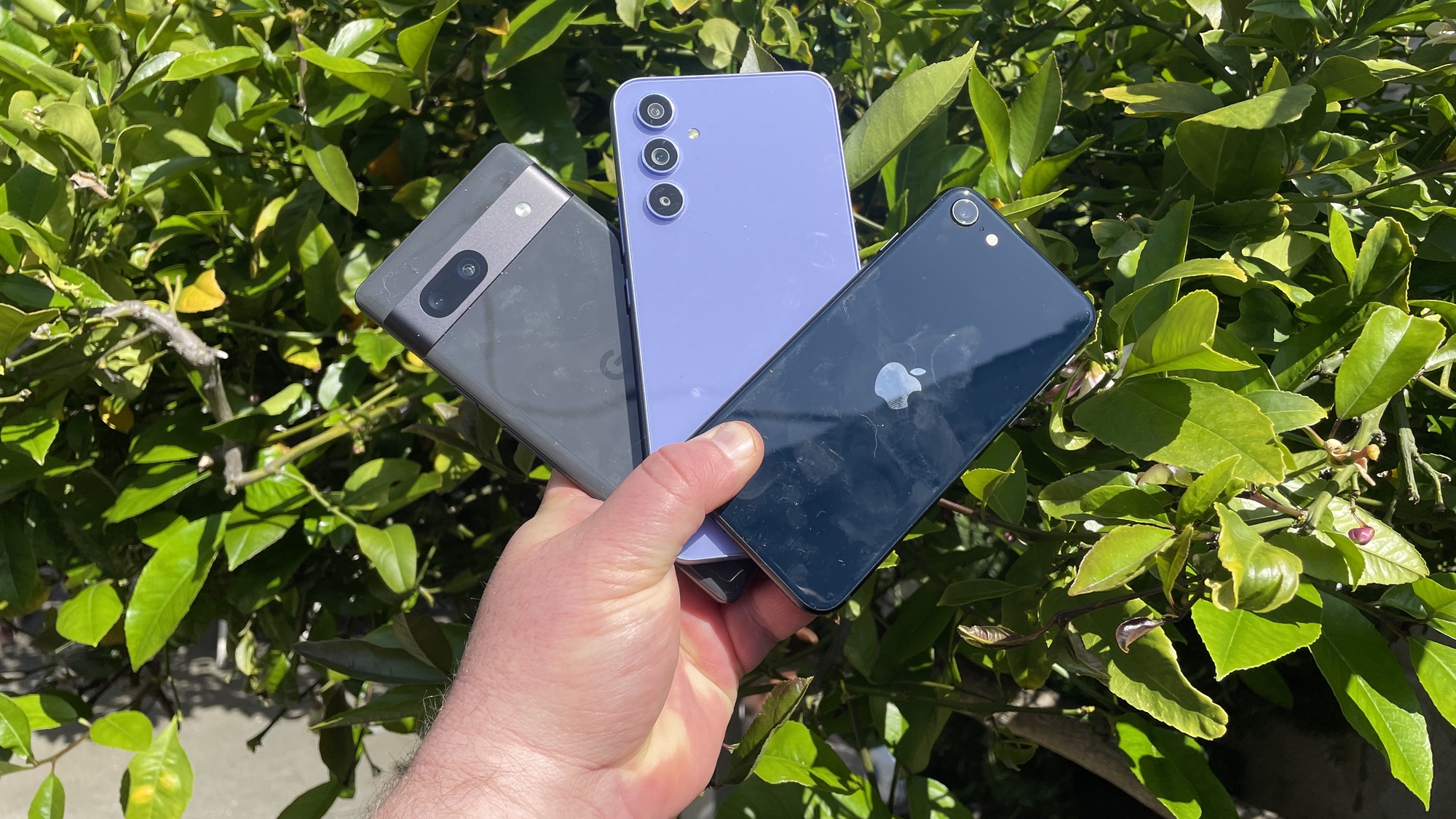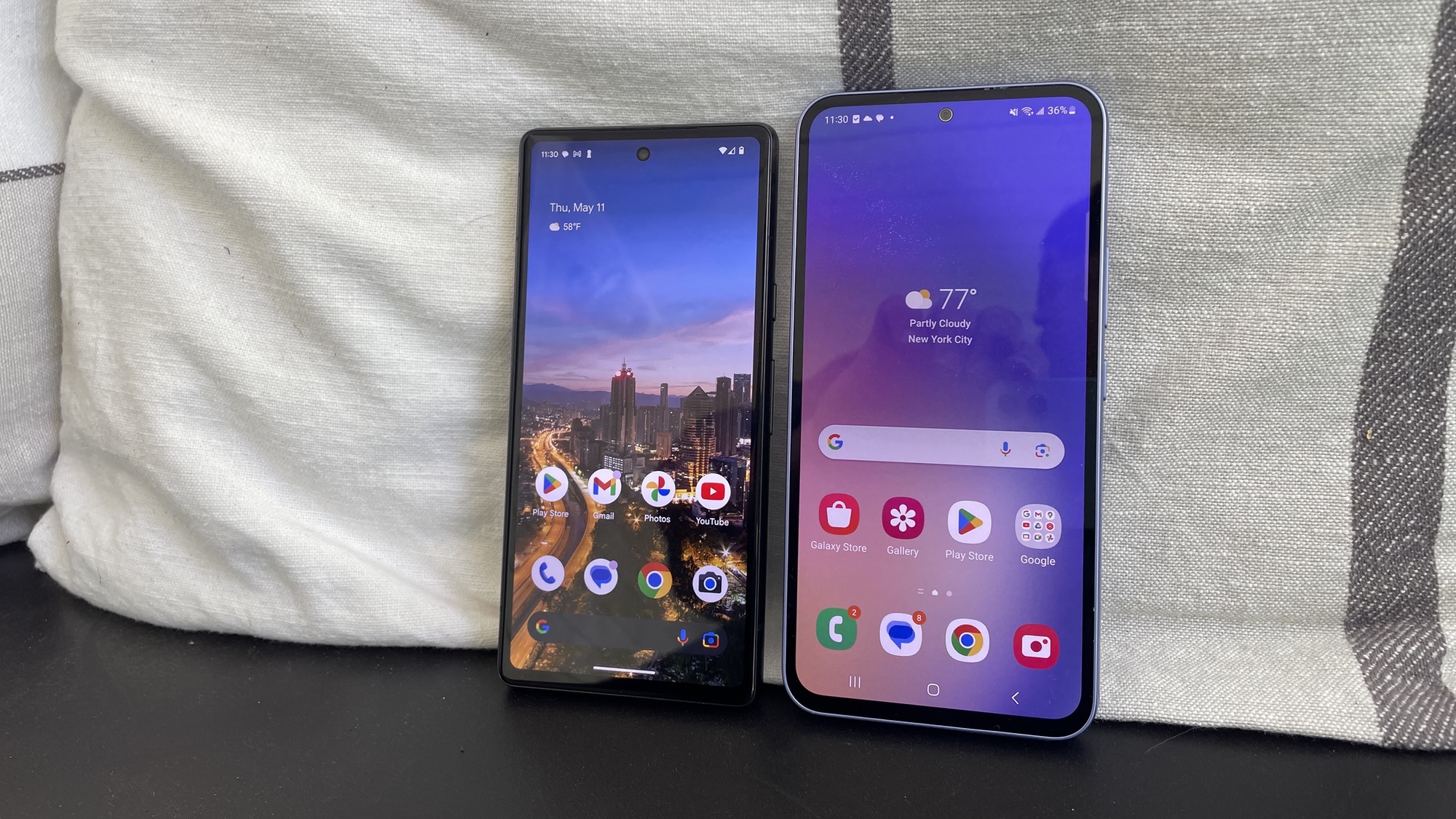Pixel 7a, Galaxy A54 show that Apple is clueless when it comes to cheaper phones
Samsung and Google have gotten serious about midrange phones, and it's making the iPhone SE look silly

I've been spending a lot of time with some lower cost phones lately, so that I could complete both my Samsung Galaxy A54 and Google Pixel 7a reviews. All the testing and trials wasn't merely so that I could evaluate those individual phones in a vacuum — I'm also trying to assess how they compare to one another as prime candidates for the title of the best cheap phone under $500.
Since these two devices also happen to be among the best Android phones I've tested this year, it's a pretty even comparison. The Pixel 7a runs on a new Tensor G2 chip, adds a fast refreshing display along with wireless charging support and bolsters its cameras with a 64MP main shooter. The Galaxy A54 has a number of impressive features in its own right — a 120Hz display and a much improved main camera of its own — and it costs $50 less than the Pixel 7a.
Next to either the Galaxy A54 or Pixel 7a, the iPhone SE 2022 looks absolutely laughable.
Honestly, you couldn't go wrong picking either phone, and I go back and forth as to which one is better than the other. The only thing I know for certain after extensively using the Galaxy A54 and Pixel 7A is that next to either device, the iPhone SE 2022 looks absolutely laughable.
This is probably an unfair comparison. The Samsung and Google phones are brand news, while the iPhone SE just celebrated its first birthday. It's tempting to overlook the tried and true when something new and shiny comes along.
Also, no matter what else we see about the iPhone SE from here on out, nobody's going to deny that it's still the top-performing phone under $500, especially with that A15 Bionic to power the device. And that's not even the most recent A15 Bionic found in the iPhone 14, but the version of Apple's chipset that powered the iPhone 13 lineup. And it's worth remember that the iPhone SE costs less than both the Galaxy A54 and Pixel 7a.
Where the iPhone SE falls short
Still, setting aside performance and price, in every other way that counts for budget smartphones, the iPhone SE is lapped by devices from Samsung and Google. And that should be pretty embarrassing for a company that prides itself on making devices that are best in their particular class.

We can start with the look of the different midrange phones. The Galaxy A54 mimics the style Samsung has adopted for its flagship Galaxy S lineup, while the Pixel 7a is a dead ringer for the Pixel 7 flagships. True, these budget phones are made out of cheaper materials than their pricier counterparts, but they don't look cheap.
"Cheap" isn't necessarily the word to describe the iPhone SE, but "out-of-date" is. Instead of adapting a more recent design, Apple continues to use the iPhone 8's aging look. That means large bezels at the top and bottom of the phone that make the entire iPhone SE experience feel cramped.
On the camera front, both Samsung and Google made improvements to the hardware on their current midrange phones, threatening to leave the iPhone SE further behind. The Galaxy A54 now uses the same 50MP sensor for its main camera that you'll find in the Galaxy S23. Google boosted the 12.2MP main shooter on the Pixel 6a to a 64MP sensor on the Pixel 7a. In contrast, the iPhone SE has that single 12MP camera on its back.
Megapixels certainly aren't everything, but the large sensors on the Galaxy A54 and Pixel 7a can gather in more light, resulting in more detailed photos. Take the two photos above of a statue paying tribute to Willie Stargell that I shot with a Pixel 7a and an iPhone SE. I think the iPhone SE's photo is actually quite good-looking, thanks in part to Apple's photo processing prowess. But the Pixel 7a shows off a more realistic sky, and captures greater detail in the base of the statue. The brick walkway around the statue also seems more detailed in the Pixel 7a photo.
You can't necessarily fault the iPhone SE for offering only one rear camera — there's no ultrawide lens here. But the lack of any kind of night photo feature on the iPhone SE remains a mystery to me. And you can see what that means for low light photos in that image of stuffed animals up above. You can distinctly see the three stuffies in the Pixel 7a's effort, even though there's minimal ambient lighting to illuminate the scene. You can barely make out the stuffed animals in the iPhone SE image, and forget about finding those plowers that peak out of the background of the Pixel 7a shot.
There's one other area where midrange phones are starting to leave the iPhone SE in their rear view mirror, and that's battery life. On our battery test, in which a phone is left to surf the web over cellular until it runs out power, the iPhone SE recorded a time of 9 hours and 5 minute. That's 50 minutes behind the average smartphone, give or take.
More significantly, it trails the results of both the Pixel 7a and Galaxy A54. The Pixel 7a lasted 10 hours and 5 minutes on our test — admittedly, that was with its 90Hz refresh rate turned off. (At least the Pixel 7a has a fast refreshing display; that's not an option for the iPhone SE.) The Galaxy A54 did even better at 10 hours and 20 minutes, and when you turn off its fast-refreshing display, it becomes one of the devices with the best phone battery life that we've tested.
Where Apple goes from here
"We're not in the junk business," Apple CEO Tim Cook famously told Bloomberg a decade ago when talking about why Apple didn't pursue the budget end of the smartphone market more aggressively. In the 10 years that passed, you could say that Samsung and Google aren't in the junk business either, at least not when it comes to their midrange phones.
“We never had an objective to sell a low-cost phone,” Cook also said in that same Bloomberg interview. “Our primary objective is to sell a great phone and provide a great experience, and we figured out a way to do it at a lower cost.” Apple's CEO was referring to the iPhone 5c at the time, which turned out not to be as great as Cook claimed there. But if you to apply that same quote to the iPhone SE, you'd have to concede Apple is falling short of its own goal there, too.
I wouldn't count out Apple from producing a better midrange phone, should the iPhone SE 4 ever make the transition from rumor to reality. But it's going to require an attitude shift on Apple's part.
The current iPhone SE has a "yeah, whatever" feel to it, a phone Apple threw together because consumers in some countries just aren't going to pay flagship prices for their handsets. That might have worked seven years ago when the original iPhone SE debuted, but since then other phone makers have gotten a lot more serious about midrange models. If Apple wants future iPhone SE models to compete, it's going to have to do likewise.
More from Tom's Guide
Sign up to get the BEST of Tom's Guide direct to your inbox.
Get instant access to breaking news, the hottest reviews, great deals and helpful tips.
Philip Michaels is a Managing Editor at Tom's Guide. He's been covering personal technology since 1999 and was in the building when Steve Jobs showed off the iPhone for the first time. He's been evaluating smartphones since that first iPhone debuted in 2007, and he's been following phone carriers and smartphone plans since 2015. He has strong opinions about Apple, the Oakland Athletics, old movies and proper butchery techniques. Follow him at @PhilipMichaels.
-
albatross83 ReplyStill, setting aside performance and price, in every other way that counts for budget smartphones, the iPhone SE is lapped by devices from Samsung and Google.
Yes, setting aside the possibly two biggest factors when buying a phone, you have a point.
But even setting that aside, Apple trounces Samsung and Google in sales (see, for example, https://www.tomsguide.com/news/smartphone-sales-figures-counterpoint-research ), so at best, you could make the argument that consumers are clueless, but Apple seems to know exactly what it's doing.

